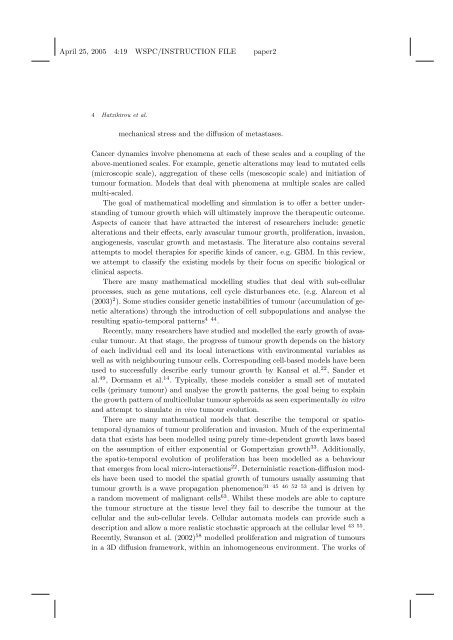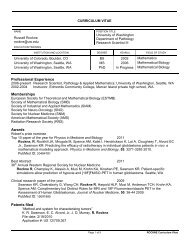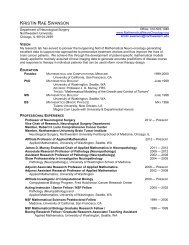April 25, 2005 4:19 WSPC/INSTRUCTION FILE paper2 ...
April 25, 2005 4:19 WSPC/INSTRUCTION FILE paper2 ...
April 25, 2005 4:19 WSPC/INSTRUCTION FILE paper2 ...
Create successful ePaper yourself
Turn your PDF publications into a flip-book with our unique Google optimized e-Paper software.
<strong>April</strong> <strong>25</strong>, <strong>2005</strong> 4:<strong>19</strong> <strong>WSPC</strong>/<strong>INSTRUCTION</strong> <strong>FILE</strong> <strong>paper2</strong><br />
4 Hatzikirou et al.<br />
mechanical stress and the diffusion of metastases.<br />
Cancer dynamics involve phenomena at each of these scales and a coupling of the<br />
above-mentioned scales. For example, genetic alterations may lead to mutated cells<br />
(microscopic scale), aggregation of these cells (mesoscopic scale) and initiation of<br />
tumour formation. Models that deal with phenomena at multiple scales are called<br />
multi-scaled.<br />
The goal of mathematical modelling and simulation is to offer a better understanding<br />
of tumour growth which will ultimately improve the therapeutic outcome.<br />
Aspects of cancer that have attracted the interest of researchers include: genetic<br />
alterations and their effects, early avascular tumour growth, proliferation, invasion,<br />
angiogenesis, vascular growth and metastasis. The literature also contains several<br />
attempts to model therapies for specific kinds of cancer, e.g. GBM. In this review,<br />
we attempt to classify the existing models by their focus on specific biological or<br />
clinical aspects.<br />
There are many mathematical modelling studies that deal with sub-cellular<br />
processes, such as gene mutations, cell cycle disturbances etc. (e.g. Alarcon et al<br />
(2003) 2 ). Some studies consider genetic instabilities of tumour (accumulation of genetic<br />
alterations) through the introduction of cell subpopulations and analyse the<br />
resulting spatio-temporal patterns 4 44 .<br />
Recently, many researchers have studied and modelled the early growth of avascular<br />
tumour. At that stage, the progress of tumour growth depends on the history<br />
of each individual cell and its local interactions with environmental variables as<br />
well as with neighbouring tumour cells. Corresponding cell-based models have been<br />
used to successfully describe early tumour growth by Kansal et al. 22 , Sander et<br />
al. 49 , Dormann et al. 14 . Typically, these models consider a small set of mutated<br />
cells (primary tumour) and analyse the growth patterns, the goal being to explain<br />
the growth pattern of multicellular tumour spheroids as seen experimentally in vitro<br />
and attempt to simulate in vivo tumour evolution.<br />
There are many mathematical models that describe the temporal or spatiotemporal<br />
dynamics of tumour proliferation and invasion. Much of the experimental<br />
data that exists has been modelled using purely time-dependent growth laws based<br />
on the assumption of either exponential or Gompertzian growth 33 . Additionally,<br />
the spatio-temporal evolution of proliferation has been modelled as a behaviour<br />
that emerges from local micro-interactions 22 . Deterministic reaction-diffusion models<br />
have been used to model the spatial growth of tumours usually assuming that<br />
tumour growth is a wave propagation phenomenon 31 45 46 52 53 and is driven by<br />
a random movement of malignant cells 63 . Whilst these models are able to capture<br />
the tumour structure at the tissue level they fail to describe the tumour at the<br />
cellular and the sub-cellular levels. Cellular automata models can provide such a<br />
description and allow a more realistic stochastic approach at the cellular level 43 55 .<br />
Recently, Swanson et al. (2002) 58 modelled proliferation and migration of tumours<br />
in a 3D diffusion framework, within an inhomogeneous environment. The works of





